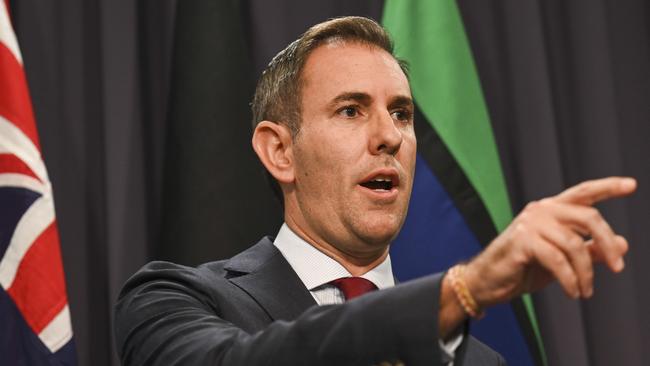Gas producers fear tax hike as exports hit record levels
Investors are bracing for a hefty tax hike for big gas producers as Treasurer Jim Chalmers prepares for a potential overhaul of the petroleum resource rent tax.
Investors are bracing for a hefty tax hike for big gas producers as Treasurer Jim Chalmers prepares for a potential overhaul of the petroleum resource rent tax, with Macquarie analysts saying Woodside Energy is the company most exposed.
The Treasurer is widely expected to announce changes to the PRRT in next month’s federal budget amid political criticism that it has not done enough to capture taxpayer revenue from oil and gas companies, especially at a time of high energy prices.
The Greens are also agitating for change, saying if the PRRT was applied to onshore gas projects, plus a 10 per cent royalty on offshore projects, it would generate an extra $29.1bn for the budget out to 2025-26.
Australian gas producers are set to break their export supply record in 2023 after reaping $90bn in earnings last year – an all-time high.
A price surge last year, partly triggered by Russia’s invasion of Ukraine, resulted in Australia’s LNG export earnings rising 82 per cent on the previous year, the highest annual figures ever generated for Australian shipments of the fossil fuel.
But a Woodside spokeswoman said this has correlated with a 300 per cent increase in the taxes and royalties it paid last year compared with 2021 – and recent turbulence in global energy markets had been a “stark reminder of the importance of energy security and affordability”. “Woodside is a significant Australian taxpayer and across our portfolio of Australian assets, we contribute 46 cents in every dollar of profit with federal and state governments,” the Woodside spokeswoman said.
“In 2022 we paid $2.7bn in Australian tax and royalties. Our contributions to PRRT are substantial – $720m paid in PRRT in 2022 – and are expected to remain strong.”
The Woodside spokeswoman said stable tax and fiscal settings were “critical for large, long-term investments that support energy security, decarbonisation and economic growth”.
“It is important that any proposed changes to fiscal terms are progressed through a collaborative and consultative approach, are based on sound modelling and analysis and are designed to protect Australia as an investment destination.”

Mr Chalmers flagged changes to the PRRT last October, saying “there is an appetite in the Australian community to see if that tax can operate more effectively”.
Macquarie analysts said future Australian LNG investment was limited, and the government was likely to focus on maximising collection from offshore projects as reserves deplete.
The October budget estimated the PRRT would raise $2.6bn this financial year, and $9.2bn over the four financial years to 2025-26. “Government is clearly reviewing options to increase tax revenues – and bring forward PRRT receipts – to help stem federal budget deficits. LNG projects now appear an easier target politically,” Macquarie wrote in a note to investors.
“We expect Treasury will be most focused on the taxing point of gas for integrated LNG Projects. Other areas of focus could include deductibility of costs, transferability/pooling of costs, uplift rates as costs are carried forward and cash refunds during the decommissioning phase when revenue streams have expired.”
Macquarie said Woodside was the most exposed to an overhaul of the PRRT, citing its Pluto, Julimar-Brunello and Scarborough projects.
“We preliminarily estimate valuation impact could be down 2-5 per cent if a higher weighting to netback pricing is applied on WA (Western Australia) LNG PRRT,” the analysts said.
Macquarie also said Santos could also “face some similar impacts”. “Devil will be in the details. We reiterate our preference for Santos over Woodside.”

Australia’s offshore LNG projects were set to move into PRRT payable status over the next 10-15 years, Macquarie said, adding that some should enter paying status sooner.
“This will see the government’s PRRT revenue grow materially from the $2-3bn levels forecast in the budget forward estimates over FY23-26e.
“The quantum and timing of PRRT receipts is closely linked to commodity prices and asset efficiency, however the 2017 Callaghan Review modelled three scenarios which quantified PRRT receipts under the existing framework were expected to range between $48bn and $106bn from 2018 to 2050. The prize for government is large.”
The former Coalition government commissioned a review by economist Mike Callaghan in late 2016, which found that stable fiscal settings were important for companies planning long-term petroleum investments.
Then treasurer Scott Morrison said at the time that the Callaghan report found the decline in PRRT revenue “does not, in itself, indicate the Australian community is being short-changed in receiving an equitable return from the development of its resources”.
But a wide view has developed among experts that the PRRT has not been effective in capturing a fair share of the super cycle in gas and oil profits for taxpayers, and is generally not fit for purpose in the high-cost gas industry.
Mr Chalmers late last year restarted a Treasury review – begun under the former government – into the PRRT’s application to gas production.




To join the conversation, please log in. Don't have an account? Register
Join the conversation, you are commenting as Logout